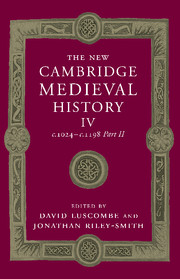Book contents
- Frontmatter
- 1 Introduction
- 2 The papacy, 1024–1122
- 3 The western empire under the Salians
- 4 Italy in the eleventh century
- 5 The kingdom of the Franks to 1108
- 6 Spain in the eleventh century
- 7 England and Normandy 1042–1137
- 8 The Byzantine Empire, 1025–1118
- 9 Kievan Rus’, the Bulgars and the southern Slavs, c. 1020 – c. 1200
- 10 Poland in the eleventh and twelfth centuries
- 11 Scandinavia in the Eleventh and Twelfth Centuries
- 12 Hungary in the Eleventh and Twelfth Centuries
- 13 The papacy, 1122–1198
- 14 The western empire, 1125–1197
- 15 Italy in the twelfth century
- 16 Spain in the twelfth century
- 17 The kingdom of the Franks from Louis VI to Philip II
- 18 England and the Angevin dominions, 1137–1204
- 19 Scotland, Wales and Ireland in the Twelfth Century
- 20 The Byzantine Empire, 1118–1204
- 21 The Latin East, 1098–1205
- 22 ’Abbasids, Fatimids and Seljuqs
- 23 Zengids, Ayyubids and Seljuqs
- Appendix: genealogical tables
- List of primary sources
- Bibliography of Secondary Works Arranged by Chapter
- Index
- Map 1a The western empire: Burgundy and Provence in the eleventh century"
- Map 1b The western empire: Germany and the north-eastern frontier of Christendom in the eleventh century"
- Map 3 The kingdom of the Franks"
- Map 4 England and Normandy"
- Map 10 Germany under Frederick Barbarossa, c. 1190">
- Map 12 The Angevin empire"
- References
11 - Scandinavia in the Eleventh and Twelfth Centuries
Published online by Cambridge University Press: 28 March 2008
- Frontmatter
- 1 Introduction
- 2 The papacy, 1024–1122
- 3 The western empire under the Salians
- 4 Italy in the eleventh century
- 5 The kingdom of the Franks to 1108
- 6 Spain in the eleventh century
- 7 England and Normandy 1042–1137
- 8 The Byzantine Empire, 1025–1118
- 9 Kievan Rus’, the Bulgars and the southern Slavs, c. 1020 – c. 1200
- 10 Poland in the eleventh and twelfth centuries
- 11 Scandinavia in the Eleventh and Twelfth Centuries
- 12 Hungary in the Eleventh and Twelfth Centuries
- 13 The papacy, 1122–1198
- 14 The western empire, 1125–1197
- 15 Italy in the twelfth century
- 16 Spain in the twelfth century
- 17 The kingdom of the Franks from Louis VI to Philip II
- 18 England and the Angevin dominions, 1137–1204
- 19 Scotland, Wales and Ireland in the Twelfth Century
- 20 The Byzantine Empire, 1118–1204
- 21 The Latin East, 1098–1205
- 22 ’Abbasids, Fatimids and Seljuqs
- 23 Zengids, Ayyubids and Seljuqs
- Appendix: genealogical tables
- List of primary sources
- Bibliography of Secondary Works Arranged by Chapter
- Index
- Map 1a The western empire: Burgundy and Provence in the eleventh century"
- Map 1b The western empire: Germany and the north-eastern frontier of Christendom in the eleventh century"
- Map 3 The kingdom of the Franks"
- Map 4 England and Normandy"
- Map 10 Germany under Frederick Barbarossa, c. 1190">
- Map 12 The Angevin empire"
- References
Summary
in the eleventh century the northern and central parts of the Scandinavian peninsula were occupied by a people who are often called Lapps but who called themselves Saami. They were ethnically distinct from the Scandinavians who lived in the coastal regions and southern part of the peninsula and in Denmark, but centuries of contact and intermarriage had resulted in some assimilation of these two peoples. The Saami, who spoke a form of Finnish, supported themselves mainly by hunting, trapping and fishing. Despite their isolation many Saami were forced to render part of their catch, in particular furs, to their Scandinavian neighbours. The Scandinavians spoke various dialects of a common Germanic language known as Old Nordic. At the beginning of the eleventh century they were predominantly pastoral farmers but 200 years later there had been a huge extension of arable cultivation at the expense of woodland and pasture in many parts of Scandinavia.
Contemporaries distinguished four main groups of Scandinavians: Danes, Götar, Svear and Norwegians or Northmen (a name that foreigners sometimes used to describe all Scandinavians). These collective names were used for the inhabitants of distinct regions. The Danes occupied Jutland and the neighbouring islands but their territory was considered to include areas that they had long dominated in what is now the west coast and southern part of Sweden. The Götar (Old Norse Gauti, Latin Gothi) occupied the plains of central southern Sweden, separated from Danish territory by forest. Lake Vättern divided the east from the west Götar (Modern Swedish Östgötar, Västgötar) after whom the medieval provinces of Östergötland and Västergötland were named.
Keywords
- Type
- Chapter
- Information
- The New Cambridge Medieval History , pp. 290 - 303Publisher: Cambridge University PressPrint publication year: 2004
References
- 2
- Cited by

